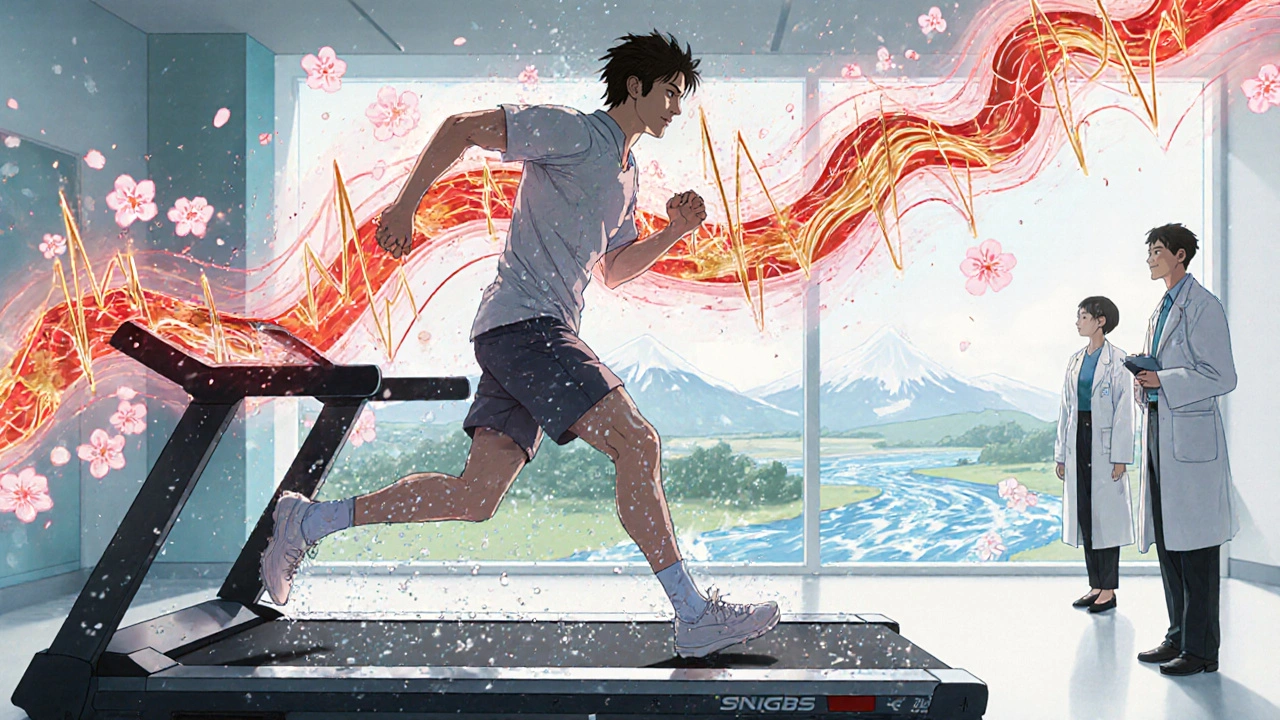What Is an ECG Test?
An ECG (electrocardiogram), sometimes called an EKG, is a simple, painless test that records your heart’s electrical activity. Electrodes-small sticky patches-are placed on your chest, arms, and legs. These pick up the tiny electrical signals your heart sends out every time it beats. The machine turns those signals into a graph, showing how fast your heart is beating, whether the rhythm is regular, and if there’s any damage or abnormal activity.
This test takes only 3 to 5 minutes. You lie still, and there’s no shock, no needles, and no discomfort. It’s often the first test doctors order when someone has chest pain, shortness of breath, dizziness, or an irregular heartbeat. A resting ECG can spot signs of a past heart attack, abnormal heart rhythms like atrial fibrillation, or thickened heart muscle. But here’s the catch: if your heart looks fine while you’re sitting still, it doesn’t mean everything’s okay. That’s where stress tests come in.
Why Do You Need a Stress Test?
Not all heart problems show up when you’re at rest. Think of it like checking a car engine while it’s idling-you might miss issues that only appear when it’s under pressure. A stress test pushes your heart to work harder, usually by making you walk on a treadmill or ride a stationary bike. If you can’t exercise, doctors use medications like adenosine or dobutamine to mimic the effects of physical exertion.
The goal? To see how your heart responds when it’s forced to pump harder. During the test, your ECG, blood pressure, heart rate, and oxygen levels are monitored continuously. If part of your heart isn’t getting enough blood-maybe because of a narrowed artery-you’ll see changes on the ECG, or your heart might start beating abnormally. These signs help doctors spot coronary artery disease (CAD), the most common cause of heart attacks.
How Does a Stress Test Work?
The most common type is the exercise stress test, often using the Bruce protocol. You start walking slowly on a treadmill with a slight incline. Every three minutes, the speed and slope increase. The test continues until you’re too tired, your heart rate hits 85% of your maximum (calculated as 220 minus your age), or you develop symptoms like chest pain, dizziness, or extreme shortness of breath.
For people who can’t exercise-due to arthritis, lung disease, or other issues-chemical stress tests are used. These drugs make your heart beat faster and harder, just like exercise would. You might feel flushed, short of breath, or have a funny taste in your mouth. These side effects are normal and last only a few minutes. The test itself takes 10 to 15 minutes for exercise, and up to an hour for chemical stress tests.
Some stress tests include imaging. Stress echocardiography uses ultrasound to take pictures of your heart before and after stress. It can show if parts of the heart muscle aren’t moving properly-clear signs of blocked arteries. Another option, nuclear stress testing, involves a small amount of radioactive dye. Special cameras detect how well blood flows to your heart muscle during rest and stress. It’s more accurate but exposes you to radiation-about the same as 3 to 4 years of natural background exposure.
How Accurate Are These Tests?
No test is perfect. A standard ECG stress test catches about 68% of people with coronary artery disease (sensitivity) and correctly rules it out in 77% of people without it (specificity). That means about 1 in 3 people with CAD might get a false negative-especially women, whose symptoms and heart responses can differ from men’s.
Stress echocardiography improves accuracy. It has a specificity of 88%, meaning it’s better at ruling out disease than a regular stress test. Nuclear tests are more sensitive (85-89%), so they catch more cases, but they’re also more expensive and involve radiation.
Costs vary widely. A CT scan of the heart runs around $400. A stress echocardiogram costs about $500. Nuclear stress tests? Around $950. But cost isn’t everything. A 2015 study found that over three years, the total healthcare spending was similar whether patients got a CT scan or a stress test. So choosing the right test depends on your risk, symptoms, and what your doctor thinks will give the clearest answer.

What Do the Results Mean?
Your results are interpreted by a cardiologist looking at several things:
- Changes in your ECG pattern-especially depression of the ST segment-can signal reduced blood flow to the heart.
- How long you lasted on the treadmill. Each extra minute you exercise lowers your risk of future heart problems by about 12%.
- Whether your blood pressure rose normally or dropped. A drop can be a red flag.
- Any symptoms you had-chest pain, dizziness, or extreme fatigue.
If your test is normal, it’s good news. But it doesn’t guarantee you’re free of heart disease. Some blockages are small and won’t show up unless they’re severe. If your test is abnormal, your doctor might recommend further testing-like a coronary angiogram-or start treatment with medication, lifestyle changes, or even a stent.
Who Should Get These Tests?
These tests aren’t for everyone. Guidelines say they’re most useful for people with intermediate risk of heart disease-meaning you have some risk factors (like high blood pressure, high cholesterol, smoking, or family history), but no clear signs of heart disease yet.
Doctors usually don’t recommend them for people with very low risk (no symptoms, no risk factors) because the chance of a false positive is higher than the chance of finding something real. They also avoid them in people who’ve had a recent heart attack, have unstable heart rhythms, or are in heart failure.
Women, especially those under 55, often get false negatives on standard stress tests. That’s because their blockages are sometimes in smaller arteries, which don’t show up on traditional tests. For them, stress echocardiography is often preferred-it’s more accurate and doesn’t use radiation.
Preparing for Your Test
You don’t need to do much, but preparation matters:
- Avoid caffeine (coffee, tea, soda, chocolate) for at least 24 hours before the test-it can interfere with the medications used in chemical stress tests.
- Don’t eat a heavy meal 2 to 3 hours before.
- Wear comfortable clothes and walking shoes. You’ll be moving.
- Bring a list of your medications. Some may need to be stopped the day before.
After the test, you can usually drive home and go back to your normal routine. There’s no recovery time needed. Most clinics give you a quick summary before you leave, with a full report from your doctor within a few days.

What to Expect During the Test
Many people are nervous. You might feel anxious, sweaty, or out of breath. That’s normal. The staff will be with you the whole time. If you feel chest pain, dizziness, or severe shortness of breath, tell them immediately. They’ll stop the test right away.
Some patients describe chemical stress tests as intense. One person on a patient forum said, "It felt like I was dying for three minutes." But the feeling fades fast. The staff knows exactly what to expect and will reassure you.
For others, the treadmill test is easier than expected. One Reddit user said he lasted 12 minutes and the test caught a silent ischemia his resting ECG missed. That’s the power of stress testing-it finds what rest can’t.
What’s New in Heart Testing?
Technology is making these tests smarter. New software using artificial intelligence can analyze ECG patterns during stress tests with 18-22% greater accuracy than human interpretation alone. That means fewer missed diagnoses and fewer false alarms.
There’s also new portable equipment, like the Cardiac Dynamics StressPal, approved in late 2022. It lets doctors run stress tests in clinics, nursing homes, or even ambulances-not just hospitals. That’s a big deal for older or mobility-limited patients.
At Stanford, researchers are combining stress echocardiography with a technique called speckle-tracking strain analysis. It’s especially good at spotting microvascular disease in women-where arteries are narrowed but not blocked. This could change how we diagnose heart disease in women, who’ve been underdiagnosed for decades.
Final Thoughts
ECGs and stress tests aren’t fancy or high-tech, but they’re among the most powerful tools we have for catching heart disease early. They’re safe, widely available, and cost-effective compared to surgery or long-term medication for undiagnosed problems.
If you’re over 40, have risk factors, or have unexplained symptoms like fatigue or chest discomfort, talk to your doctor. Don’t assume a normal resting ECG means you’re in the clear. Sometimes, the heart only whispers its problems when it’s under stress-and that’s when you need to listen.

Jefriady Dahri
November 25, 2025 AT 09:53Also, caffeine before the test? Big mistake. I had a matcha latte at 8am and the chemical stress test felt like my heart was trying to escape through my ribs. Lesson learned.
Arup Kuri
November 25, 2025 AT 10:25Elise Lakey
November 25, 2025 AT 16:41Timothy Sadleir
November 27, 2025 AT 15:58Rachel Villegas
November 29, 2025 AT 03:54Aki Jones
November 30, 2025 AT 11:58Erika Hunt
December 2, 2025 AT 05:22Sharley Agarwal
December 3, 2025 AT 00:58prasad gaude
December 3, 2025 AT 00:59Roscoe Howard
December 4, 2025 AT 21:36